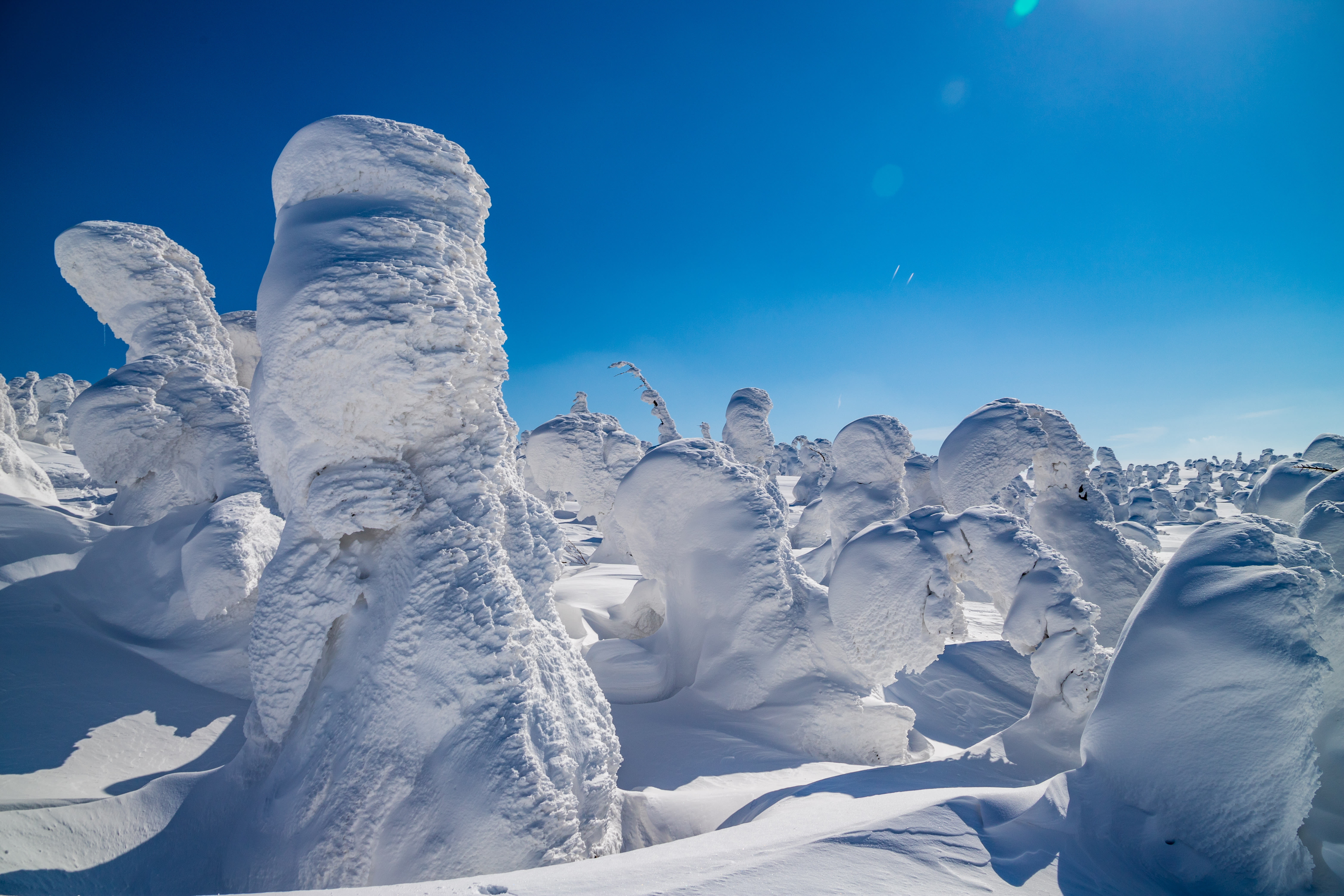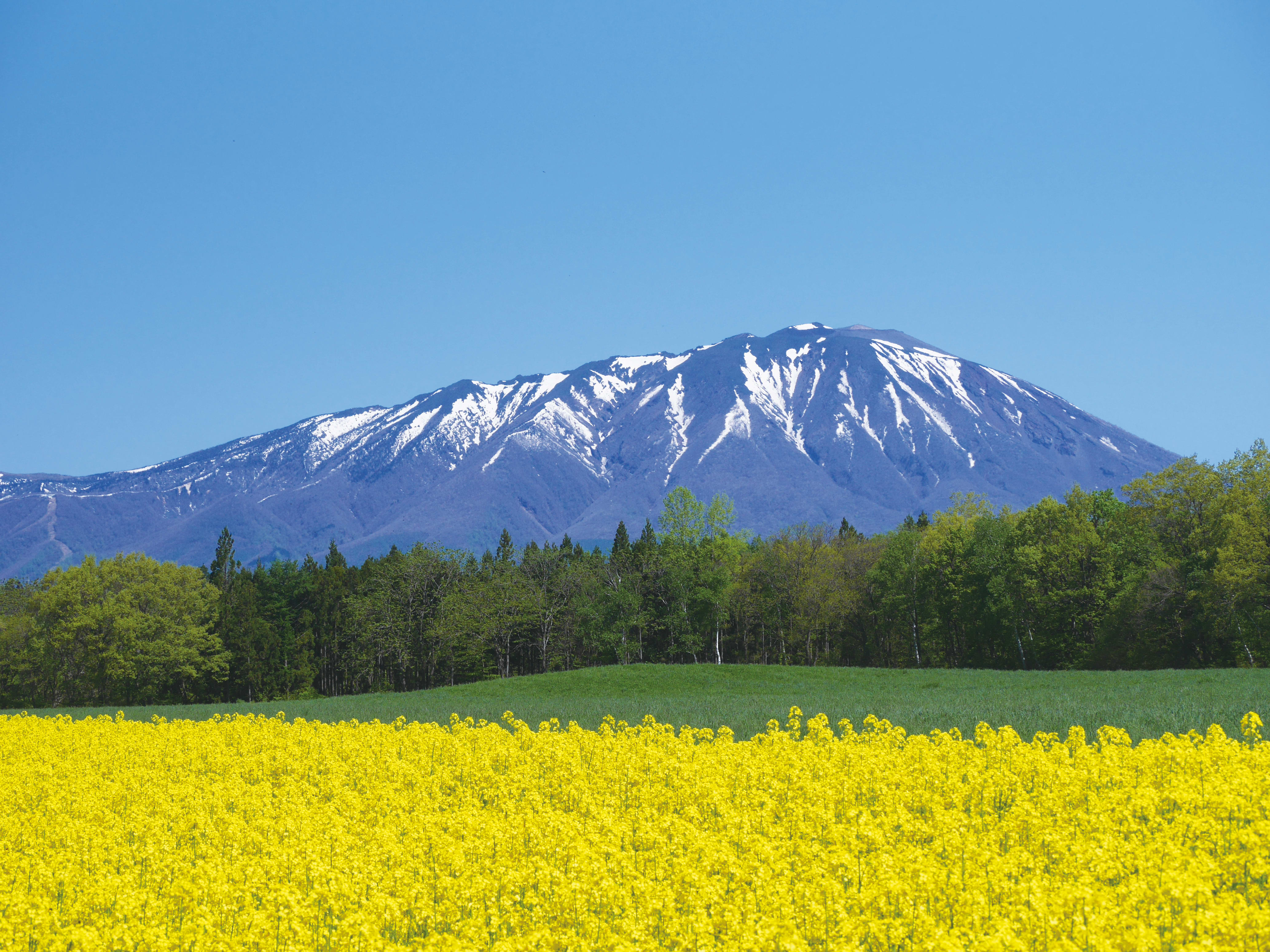Don't Miss
- Taking a leisurely sightseeing cruise on Lake Towada
- Seeing the eerie yet beautiful "juhyo" (snow monsters) in winter
- Soaking in the mountain hot springs of Nyuto Onsen
- Following the river path through Oirase Gorge
Nestled in the mountainous interior of northern Honshu, Towada-Hachimantai National Park offers stunning natural scenery and endless outdoor activities in every season. In spring, delicate green leaves overhang the Oirase Gorge, and alpine flowers carpet the slopes of Mount Akita-Komagatake each summer. The trees around Lake Towada blaze with color in autumn, and heavy snowfall in winter invites skiing, snowboarding and snowshoeing throughout the park.
Towada-Hachimantai National Park is characterized by steaming hot springs, placid lakes in the calderas of ancient volcanoes, and mountain peaks capped with snow. These landscapes have inspired spiritual journeys and storytelling for millennia, leaving the region rich in shrines, pilgrimage routes, and folk tales.
The park, which covers an area of 85,534 hectares, is split into two zones: Towada-Hakkoda to the north, defined by the majestic Hakkoda Mountains and tranquil Lake Towada; and Hachimantai to the south, dominated by Mount Akita-Komagatake, Mount Iwate and Mount Hachimantai.
The Hakkoda Mountains include over 20 volcanoes, with Mount Odake the highest at 1,585 meters. These mountains are crisscrossed by numerous hiking routes and several steaming hot springs. As you climb, the trees change from forests of beech to Maries’ fir (Abies mariesii) and then to Japanese stone pines above 1,200 meters. In the winter months, the trees in the higher reaches are covered in hoarfrost and snow, taking on the strange, twisting shapes known as juhyo (snow monsters).
To access the higher reaches of Hakkoda, you can take a ropeway offering dramatic views over the horizon, and in the winter plenty of juhyo. On several peaks you’ll find ski resorts offering downhill and backcountry skiing.
In the eastern section of the Towada-Hakkoda area is Oirase Gorge. A scenic and gentle walking trail along the Oirase Stream stretches 14-kilometers through the valley, passing through mixed-growth forest and moss-covered rocks and roots, with views of several waterfalls. During winter there are tours to see the frozen waterfalls illuminated at night.
The largest caldera lake in Honshu is the vast Lake Towada, pooled in a caldera that formed around 200,000 years ago. The shores are pleasantly undeveloped, especially to the north of the lake. To the south is Yasumiya, the most developed part of the shore, from where regular sightseeing boats depart (except during winter months). Some cross to Nenokuchi on the lake’s eastern side, by Oirase Gorge. Canoe tours enable you to take a closer, more leisurely look at the lake, while staying overnight at a campsite means you can enjoy the area’s natural beauty with far fewer visitors.

With its lakes, marshes and moors, the Hachimantai area offers wild and varied landscapes ringed by multiple volcanoes, including Mount Hachimantai (1,613 m)—its flat top is often called Hachimantai Plateau. Alpine plants and Maries’ fir trees (which transform into juhyo each winter) grow on its slopes, and there are wetlands and ponds near the summit.
The range of habitats in these mountains are home to a wide variety of wildlife, including Japanese serow, Asiatic black bears, forest green tree frogs, great spotted woodpeckers and Japanese giant flying squirrels (musasabi). Golden eagles are also occasionally spotted in the park.
Car access is via the Hachimantai Aspite Line, a scenic road that runs across the northern corner of this section of the park. The road is inaccessible in winter, but when it reopens in April, cars pass between towering, sheer walls of snow on either side. The Hachimantai Jukai Line heads south from Mount Hachimantai to Matsukawa Onsen.
Nearby Goshogake Onsen is a rustic hot spring resort in an area with high volcanic activity, where the ground is pockmarked with steam vents, thermal pools and bubbling mud volcanoes. Oyunuma Pond is an excellent spot for snowshoeing, and there are limited snowshoe tours from Goshogake to the pond in the winter. Daideikazan Mud Volcano is Japan’s largest mud volcano, with mineral-rich mud up to 8 meters deep in places. From Goshogake, a 7-kilometer hiking trail leads to Tamagawa Onsen, which boasts Japan’s most acidic hot spring water. The springs of Tamagawa have a pH of around 1 and contain mildly radioactive hokutolite stones. One water source here sends out 9,000 liters of boiling water per second, making it Japan’s most productive hot spring.
Mount Akita-Komagatake is the name given to a group of mountains in the south of the park, with Mount Onamedake the tallest peak at 1,637 meters. It is a great area for seeing alpine plants, with several hiking trails passing through verdant meadows showing blushes of pink, white or yellow flowers at different elevations in spring and summer.
This section of Towada-Hachimantai National Park is also renowned for its atmospheric onsen resorts, notably Kunimi and Nyuto. The many outdoor baths (rotenburo) in Nyuto are ready to soothe tired muscles in all seasons, but it is especially relaxing to soak in these thermal springs as snow falls around you.
In the east of the Hachimantai area is Mount Iwate, a 2,039-meter stratovolcano (the park’s highest peak) with some lovely, dramatic hiking routes. The Ohachimawari Route traces the edge of the volcano’s crater, which is dotted with statues of Kannon, the deity of mercy, and offers wonderful vistas of the surroundings.
Another trail traverses the black ground of the Yakehashiri Lava Flow, on the mountain’s northeast side, giving a startling insight into the power of this active volcano.

Northern Honshu was known for centuries for its horses, which are still celebrated today in the Chagu Chagu Umakko festival held every June. Horses in ceremonial coats of local fabric, trimmed with bells that were originally used to deter predators, are led along a 13-kilometer route from Onikoshi Sozen Shrine in Takizawa to the city of Morioka, which is on the outskirts of the park.

The area has a well-developed hot spring culture, which complements the winter sports for which it has become famous. Towada-Hachimantai receives the heaviest snowfall in Japan, and the Hakkoda, Hachimantai and Iwate mountains, in particular, have comprehensive skiing and snowboarding facilities, so it is easy to make the most of the fine and plentiful powder.
Art is also becoming a draw in the region, with beloved artworks such as the Statue of Maidens on the south shore of Lake Towada.